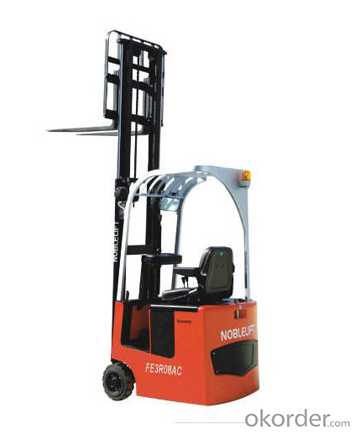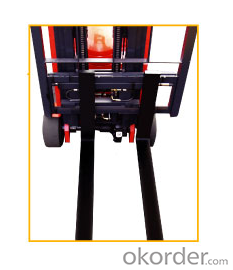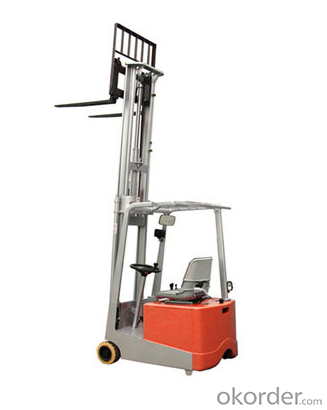Loading Port:Shanghai
Payment Terms:TT OR LC
Min Order Qty:1 unit
Supply Capability:1 unit/month
Forklift Description:
Forklifts are rated for loads at a specified maximum weight and a specified forward center of gravity. This information is located on a nameplate provided by the manufacturer, and loads must not exceed these specifications. In many jurisdictions it is illegal to remove or tamper with the nameplate without the permission of the forklift manufacturer.
An important aspect of forklift operation is that most have rear-wheel steering. While this increases maneuverability in tight cornering situations, it differs from a driver’s traditional experience with other wheeled vehicles. While steering, as there is no caster action, it is unnecessary to apply steering force to maintain a constant rate of turn.
Another critical characteristic of the forklift is its instability. The forklift and load must be considered a unit with a continually varying center of gravity with every movement of the load. A forklift must never negotiate a turn at speed with a raised load, where centrifugal and gravitational forces may combine to cause a disastrous tip-over accident. The forklift are designed with a load limit for the forks which is decreased with fork elevation and undercutting of the load (i.e., when a load does not butt against the fork "L"). A loading plate for loading reference is usually located on the forklift. A forklift should not be used as a personnel lift without the fitting of specific safety equipment, such as a "cherry picker" or "cage".
Forklifts are a critical element of warehouses and distribution centers. It’s imperative that these structures be designed to accommodate their efficient and safe movement. In the case of Drive-In/Drive-Thru Racking, a forklift needs to travel inside a storage bay that is multiple pallet positions deep to place or retrieve a pallet. Often, forklift drivers are guided into the bay through guide rails on the floor and the pallet is placed on cantilevered arms or rails. These maneuvers require well-trained operators. Since every pallet requires the truck to enter the storage structure, damage is more common than with other types of storage. In designing a drive-in system, dimensions of the fork truck, including overall width and mast width, must be carefully considered.
Forklift control and capabilities
Forklift hydraulics are controlled either with levers directly manipulating the hydraulic valves, or by electrically controlled actuators, using smaller "finger" levers for control. The latter allows forklift designers more freedom in ergonomical design.
Electric forklifts - powered by lead-acid batteries, several types of forklifts are electric: cushion tire forklifts, scissor lifts, order pickers, stackers, reach trucks and pallet jacks. Electric forklifts are primarily used indoors on flat, even surfaces. Electric forklift batteries last 6 consecutive hours or throughout an 8-hour shift with 2-3 breaks. Batteries prevent the emission of harmful fumes and are recommended for facilities in food-processing and healthcare sectors.
Fuel cell forklifts produce no local emissions, can work for a full 8-hour shift on a single tank of hydrogen, can be refueled in 3 minutes and have a lifetime of 8–10 years. Fuel-cell-powered forklifts are often used in refrigerated warehouses as their performance is not degraded by lower temperatures.
Sideloader - comes in Stand on End Control, and Sit Down End Control, which is the most numerous. It may be electrically powered, or have an internal combustion engine. Engines may be diesel, kerosene, gasoline, natural gas, butane, or propane fueled, and may be either two stroke spark ignition, four stroke spark ignition (common), two stoke compression ignition, and four stroke compression ignition (common). North American Engines come with advanced emission control systems. Forklifts built in countries such as Iran or Russia will typically have no emission control systems. Some sideloaders have hybrid drivetrains.
Forklift Specification:
Designtion | Lift height | Free lift | Closed mast height h1 mm | Extended mast height h4 mm | Tilt forward/ | without sideshift single solid rubber | |||
FE3R06AC | FE3R08AC | FE3R10AC | FE3R12AC | ||||||
Two-stage | 2500 | 0 | 1560 | 3430 | 3/5.3 | 600 | 800 | 1000 | 1200 |
3000 | 0 | 2005 | 3875 | 3/5.3 | 600 | 800 | 1000 | 1200 | |
3600 | 0 | 2305 | 4175 | 3/5.3 | 560 | 720 | 920 | 1050 | |
4000 | 0 | 2305 | 4375 | 3/5.3 | 480 | 650 | 800 | 950 | |
Two-stage full free | 2500 | 1450 | 1955 | 3835 | 3/5.3 | 600 | 800 | 1000 | 1200 |
3000 | 1500 | 2005 | 3875 | 3/5.3 | 600 | 800 | 1000 | 1200 | |
3600 | 1800 | 2305 | 4175 | 3/5.3 | 560 | 720 | 920 | 1050 | |
4000 | 2000 | 2505 | 4375 | 3/5.3 | 480 | 650 | 800 | 950 | |
Three-stage full free | 4000 | 1300 | 1780 | 4375 | 3/5.3 | 450 | 630 | 750 | 900 |
4200 | 1400 | 1880 | 5140 | 3/5.3 | 430 | 600 | 720 | 800 | |
4500 | 1500 | 2005 | 5340 | 3/5.3 | 380 | 500 | 580 | 700 | |
Identification | Manufacture(abbreviation) | Noblellift | ||||
Manufacturer’s type designation | FE3R06AC | FE3R08AC | FE3R10AC | FE3R12AC | ||
Drive:electric(battery or mains), | electric | |||||
Type of operation: hand, pedestrian, standing,seated,order-picker | seated | |||||
Load Capacity /rated load | kg | 600 | 800 | 1000 | 1200 | |
Load center distance | mm | 500 | ||||
Load distance, centre of drive axle to fork | mm | 250 | 260 | |||
Wheelbase | mm | 812/897 | 952/1037 | |||
Weights | Service Weight incl.battery(see line 6.5) | kg | 1740 | 1850 | 2050 | 2200 |
Axle loading, laden front/rear | kg | 1960/380 | 2235/415 | 2530/520 | 2720/580 | |
Axle loading, unladen front/rear | kg | 760/980 | 800/1050 | 860/1090 | 910/1290 | |
Wheels, | Tyres:solid rubber, superelastic,pneumatic,polyurethane | Solid rubber/polyurethane | ||||
Tyres size, front | 13×4 1/2×8 | |||||
Tyres size, rear | Ф254×82 | Ф310×125 | ||||
Wheels, number front/rear(x=driven wheels) | 2/1× | |||||
Track width,front | mm | 731 | ||||
Track width,rear | mm | 0 | ||||
Basic Dimensions | Mast/fork carriage tilt forward/backward | α/β | 3°/5.3° | |||
Lowered mast height | mm | 2000 | ||||
Free lift | mm | 0 | ||||
Lift height | mm | 3000 | ||||
Extended mast height | mm | 3875 | ||||
Overhead load guard height | mm | 2000 | 2090 | |||
Seat height/standing height | mm | 945 | 1030 | |||
Coupling height | mm | 760 | 860 | |||
Overall length | mm | 2290 | 2410 | |||
Length to face of forks | mm | 1290 | 1460 | |||
Overall width | mm | 845 | 850 | |||
Fork dimensions | mm | 30×100×1000 | 35×100×1150 | |||
Fork carriage width | mm | 845 | 850 | |||
Ground clearance,laden, under mast | mm | 70 | ||||
Ground clearance, center of wheelbase | mm | 65 | ||||
Aisle width for pallets 1000x1200 crossways | mm | 2775 | 2945 | |||
Aisle width for pallets 800x1200 lengthways | mm | 1890 | 1890 | |||
Turning radius | mm | 1040 | 1210 | |||
Performance Data | Travel Speed, laden/unladen | 8/9 | 8/9 | 7.5/9 | 7.0/9 | |
Lift speed, laden/unladen | m/s | 0.13/0.28 | 0.12/0.28 | 0.16/0.22 | 0.15/0.22 | |
Falling speed,laden/unladen | m/s | 0.22/0.22 | 0.23/0.22 | 0.16/0.20 | 0.17/0.20 | |
Drawbar pull laden/unladen | N | 1500/1700 | 1800/2300 | |||
Max puller,laden/unladen | N | 3320/3530 | 3420/3640 | |||
Gradient performance,laden/unladen | % | 8/12 | 8/12 | 10/15 | 10/15 | |
Service brake | hydr.+electric | |||||
E-Motor | Drive motor rating s2 60min | kw | 2.5 | 3 | ||
Lift motor rating at s3 15% | kw | 3 | ||||
Battery standard | DIN | |||||
Battery voltage, norminal capacity K5 | V/A | 24/360 | 24/460 | 24/540 | 24/600 | |
Battery weight | kg | 340 | 450 | 500 | 560 | |
Battery dimensions l/w/h | mm | 803/263/734 | 803/263/734 | 808/380/720 | 808/380/720 | |
Other Details | Type of drive control | Impulse AC | ||||
Operating pressure for attachments | MPa | 90 | 115 | 135 | 135 | |
Operating pressure for attachments | bar | 30 | ||||
Sound level at driver’s ear according to EN12053 | dB(A) | 70 | ||||
Forklift Images:



FAQ of forklift:
Q: What’s the function of forklift?
A: A forklift truck (also called a lift truck, a fork truck, or a forklift) is a powered industrial truck used to lift and move materials short distances. The forklift was developed in the early 20th century by various companies including the transmission manufacturing company Clark and the hoist company Yale & Towne Manufacturing. Following World War II the use and development of the forklift truck has greatly expanded worldwide. Forklifts have become an indispensable piece of equipment in manufacturing and warehousing operations.
Q: What’s the general operations of forklift:
A: Forklift cab with control layout.
Forklifts are rated for loads at a specified maximum weight and a specified forward center of gravity. This information is located on a nameplate provided by the manufacturer, and loads must not exceed these specifications. In many jurisdictions it is illegal to remove or tamper with the nameplate without the permission of the forklift manufacturer.
Q: What are the Forklift safety Standards?
A: 1, Forklift safety is subject to a variety of standards world wide. The most important standard is the ANSI B56—of which stewardship has now been passed from the American National Standards Institute (ANSI) to the Industrial Truck Standards Development Foundation after multi-year negotiations. ITSDF is a non-profit organization whose only purpose is the promulgation and modernization of the B56 standard.
2, Other forklift safety standards have been implemented in the United States by the Occupational Safety and Health Administration (OSHA) and in the United Kingdom by the Health and Safety Executive.
3, Driver safety: In many countries forklift truck operators must be trained and certified to operate forklift trucks. Certification may be required for each individual class of lift that an operator would use.